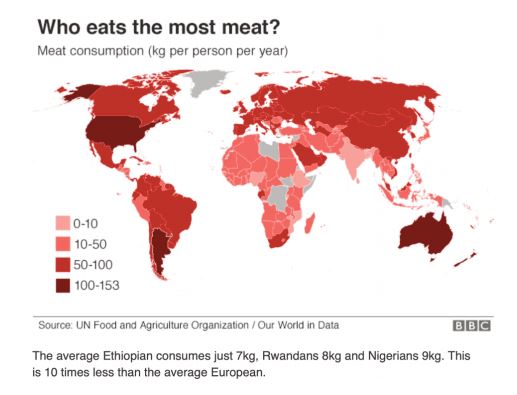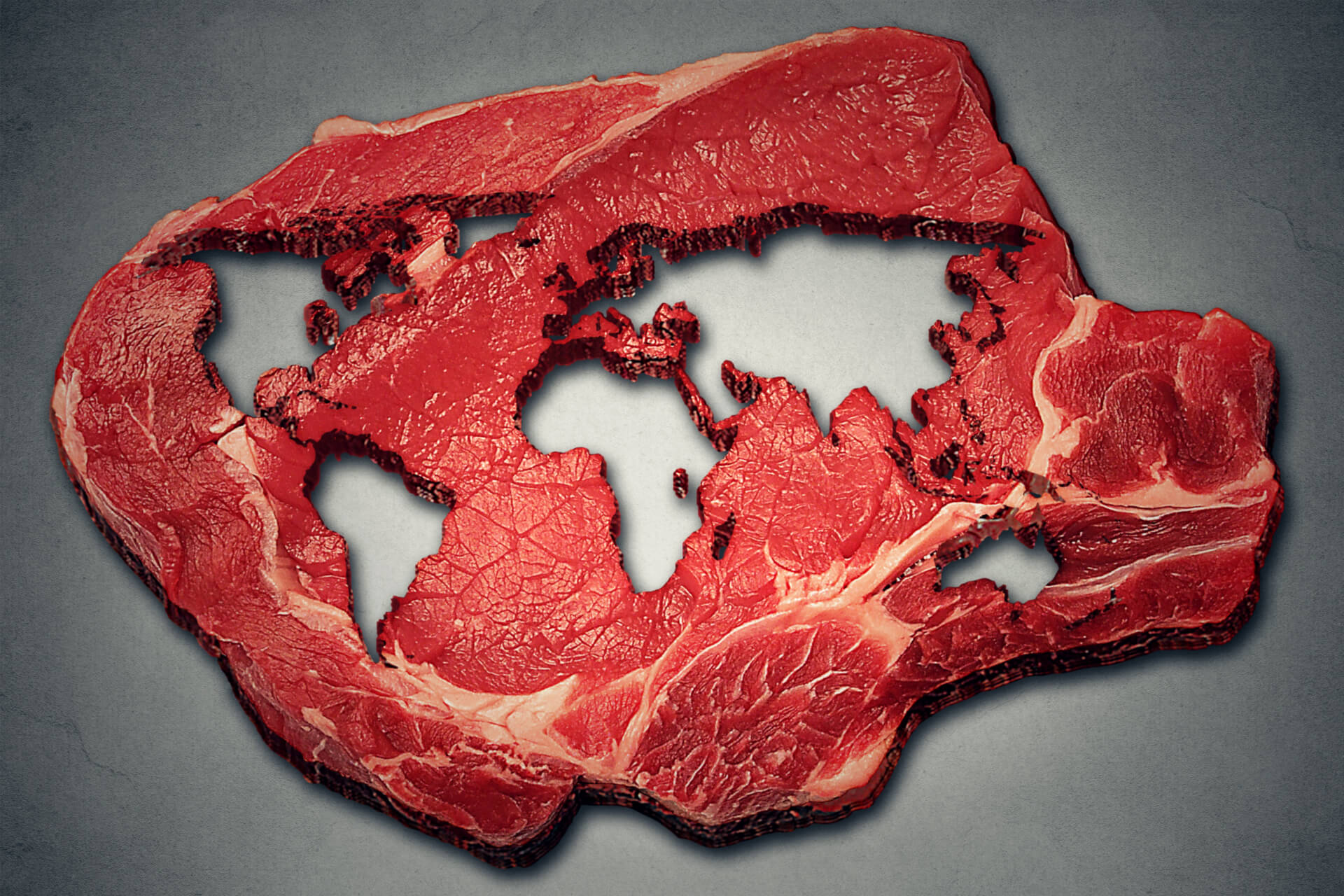Lawmakers in the European Union (EU) are considering a controversial proposal–that meat eaters should pay a tax to counter the environmental cost of the food that is on their plate.
A new report by the Dutch environmental advocacy group, True Animal Protein Price Coalition (TAPP), recommends a fair tax in line with the EU's Green Deal, on pork, beef, and chicken that is expected to create a 70% decrease in meat-consumption by 2030. But is a meat tax really necessary in the EU?
Since World War II, the excessive consumption of meat, facilitated by industrial processing methods, has been one of the biggest changes in the global food and agriculture industry, especially in ‘developed’ countries. The scale of meat production is monumental, but there is scant consideration of the impact of the inputs used and the surplus output. There is also little acknowledgment of the fact that oil, water, land, and cattle are heavily exploited to produce food, simultaneously causing water, soil, and air pollution due to the depletion of natural resources, excessive dependence on chemical fertilizers, land-use change, and increased emissions of greenhouse gases (GHGs).
The agricultural sector contributes to a third of all global GHG emissions, if fossil fuel inputs are included; this figure does not include emissions from the transport, processing, and retail of food, or its waste. Of total food-related GHG emissions, industrial dairy and meat production at the farm level have the largest impact.
The UN Food and Agriculture Organization (FAO) has calculated that livestock production makes up 16% of the globe's total GHG emissions. It also estimates about 30% of human-caused biodiversity destruction is due to intensive meat production; coupled with the continued loss of grasslands and rainforests, this has turned into an environmental crisis.
But while the Global South follows the more sustainable method of small-scale farming with local breeds and feed, industrial livestock production in the Global North is growing at a rapid rate. The FAO in 2007 found that the global average of per capita meat consumption in the world was 40 kg, with the US topping the list at 123 kg compared to India at 3 kg. The following map also illustrates the high consumption of meat in the Global North:

Hence, it makes sense that the EU, which is the global leader for climate-related policymaking, should set a precedent for sustainability in the livestock sector in the Global North.
The most obvious approach that comes to mind in terms of sustainable agricultural and livestock farming practices technological changes. Many experts have suggested changes for effective food loss and waste management, new technologies at the farming level, and feeding more concentrated diets to livestock as long-term solutions to the issue. But a major question underlying this is whether ethical farming leads to an overall reduction in the consumption, and therefore the demand, of meat.
The thought process behind putting a price tag on pollution caused by food production is similar to that of carbon emission taxes charged for fossil fuel use. The hope is that consumers will gravitate towards less-environmentally harmful food products, which in the long run would make global food pricing cheaper and more competitive. The goal is to eliminate environmental costs that are incurred between meat production and consumption, while at the same time encouraging people to consume less meat.
Certain livestock product-related taxes have already been implemented in Sweden and Denmark, leading to significant decreases in GHG production. Further, the TAPP report also includes the need for taxing meat imports, thereby suggesting a framework that can somewhat regulate global markets. If the EU implements such a tax, it would force major beef exporting countries like Brazil to regulate their production of meat.
According to the FAO, hidden costs of global food production and distribution come up to $2.3 trillion per year. These calculations suggest that food would be twice as expensive in supermarkets if these environmental and health costs were charged to customers. It is believed that in the Global North, where an average meat-based diet for a single day costs around 3600 litres of water (compared to the Global South at 2050 litres).
The introduction of a meat tax would also address the inherent conflict between animal welfare and environmental concerns, as it would demand a reduction in the overall consumption of meat, thereby reducing feed requirements and GHG levels simultaneously.
The main argument in favour of this approach is one that focuses on the differences in GHG emissions of meat versus plant-based agricultural products. In a UK report by the World Wildlife Fund and the Food Climate Research Network, it was found that the GHG emission rate of goat and sheep is estimated to be 14.61 kg CO2e/kg, beef at 12.14, pork at 4.445 and chicken meat at 2.84. In contrast, non-animal-based food products have a much lower GHG emission rate–potatoes are estimated to produce 0.26 CO2e/kg, wheat 0.52 and apples 0.32. The disparity of these numbers follows an almost identical pattern in the EU.
While GHG emissions are much higher for animal products, it is also important to note that GHG intensities of beef, goat, and sheep meat are significantly more than those of pork and chicken meat. Hence, the proposed tax rate will be weighted according to the product's GHG emissions, in what the TAPP calls fair pricing.
However, meat taxation can also have negative effects. For instance, a meat tax comparable to that of tobacco and alcohol can be perceived as a cultural and moral imposition that considers the consumption of meat as a sin, rather than a move towards sustainability. Numerous societal groups in the EU are sure to oppose such a move, especially politicians, religious groups, and those involved in farming. Unless the EU implements or offers alternative livelihood practices to rehabilitate livestock farmers, the proposed changes risk imposing huge losses on these workers.
Further, GHG emissions from this sector are far less than the transport and energy sectors, particularly in the EU. This brings forth the argument that the latter sectors require more urgent mitigation efforts than controlling meat trade and consumption. It is also more difficult to implement technological changes in agriculture compared to the energy and transport sectors, and a shift in focus would also ensure faster and more visible GHG emission reductions. That being said, even if relative emissions from transport and energy are higher than livestock, the absolute emissions remain substantial.
From an economic perspective, a major challenge for the EU is the heterogeneity of both per capita consumption and livestock practices across countries, especially in its beef sector. Farm sizes, pricing, production costs, farmer incomes, economic profitability vary vastly across borders, especially between the extreme corners of Europe. For example, in Ireland, Scotland, France, and Spain, cattle fattening is a widely followed practice; most fattening farms are located in northwestern Spain and Ireland. While fattening farms are also found in Poland and around the Alps, farmers there depend more on beef production than fattening.
Such diverse farming practices make it difficult to implement pan-EU farming norms, especially considering that the sector is driven by geographic and climatic realities. In fact, the Union has been considering a common food policy for some time, but even this demands an overhaul of the region's food governance systems and is not immediately feasible. In this case, a meat tax comes in as an intermediate measure that may later be revoked if GHG emissions reduce after a sustainability-focused restructuring of the agricultural supply chain.
Eastern European countries and regions around the Mediterranean are more vulnerable to fluctuations in the meat farming sector since farmers usually have smaller, specialized farms that have little capacity for innovation and investment. Here, carcass weight is a major driver for income levels. So, the TAPP's proposed 1 Euro flat tax rate for 2 years per kg of meat may not be equally feasible in all member EU states. That being said, the plan targets consumers and not farmers, and also includes subsidies on plant-based products. This balances food affordability in the region.
This entire conversation also opens up interesting possibilities of knowledge sharing on non-industrial farming techniques between the Global North and South. Simultaneously, such policies carry the potential of shifting climate leadership to countries like India, which have maintained traditional agricultural methods that are inherently sustainable, particularly with respect to vegetable and carabeef farming. Resource-sharing and an increased focus of climate-sensitive trade can also reduce the global usage of chemical fertilizers and pesticides.
As reiterated at the UN and at various conferences around the world, the climate crisis is too urgent to be ignored, and a consumption tax initiative is an effective immediate strategy that can see short-term results. Mitigation in all forms are required, and the fact that the EU is recognizing its complicity in livestock-related GHG emissions should be something that other developed nations in the Global North follow as well.
Reference List
Hocquette, J. F., Ellies-Oury, M. P., Lherm, M., Pineau, C., Deblitz, C., & Farmer, L. (2018). Current situation and future prospects for beef production in Europe - A review. Asian-Australasian journal of animal sciences, 31(7), 1017—1035. doi:10.5713/ajas.18.0196
Kanerva, M. (2013). Meat consumption in Europe: Issues, trends and debates. Artec-Paper, 187.
Nordgren, A. (2011). Ethical Issues in Mitigation of Climate Change: The Option of Reduced Meat Production and Consumption. Journal Of Agricultural And Environmental Ethics, 25(4), 563-584. doi: 10.1007/s10806-011-9335-1
Säll, S., & Gren, I. (2015). Effects of an environmental tax on meat and dairy consumption in Sweden. Food Policy, 55, 41-53.
Toward a more consistent combined approach of reduction targets and climate policy regulations: The illustrative case of a meat tax in Denmark. (2017). Environmental Science & Policy, 76, 78-81.
True Animal Protein Price Coalition. (2020). Aligning food pricing policies with the European Green Deal.
Image Source: Truth Theory

